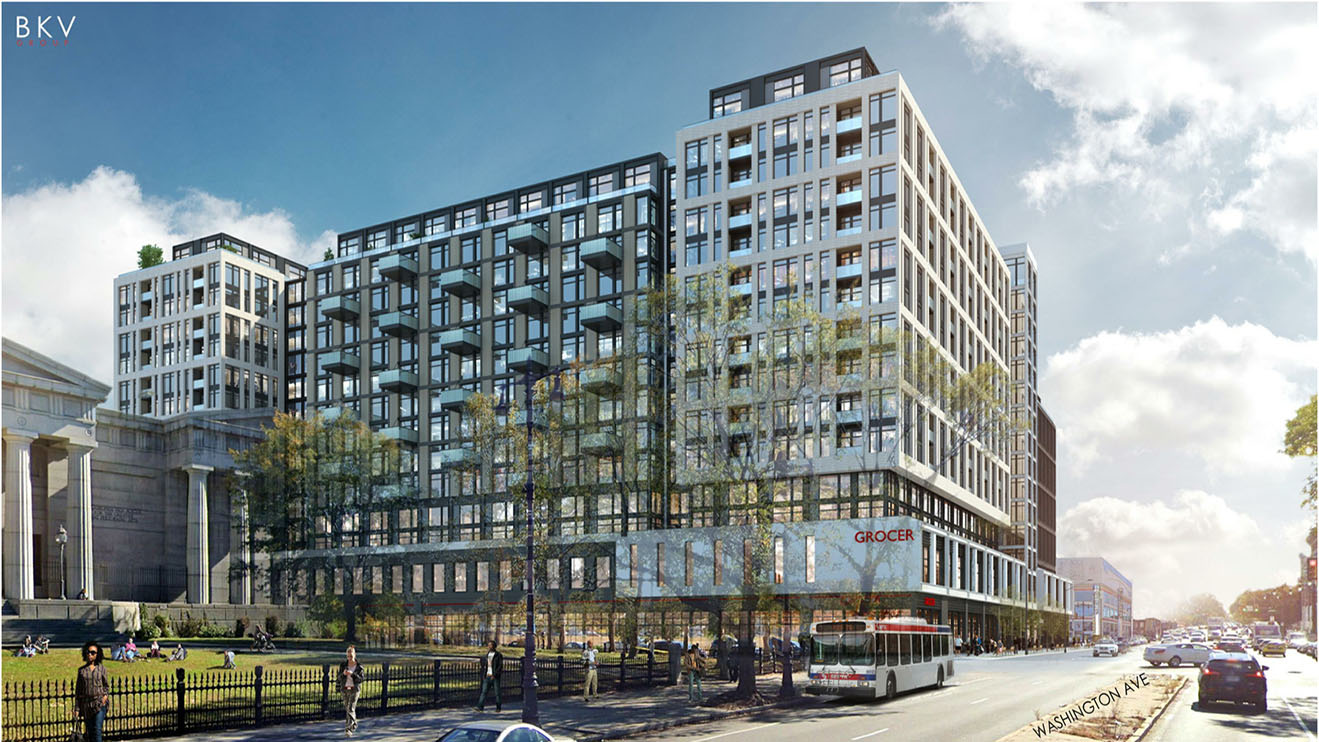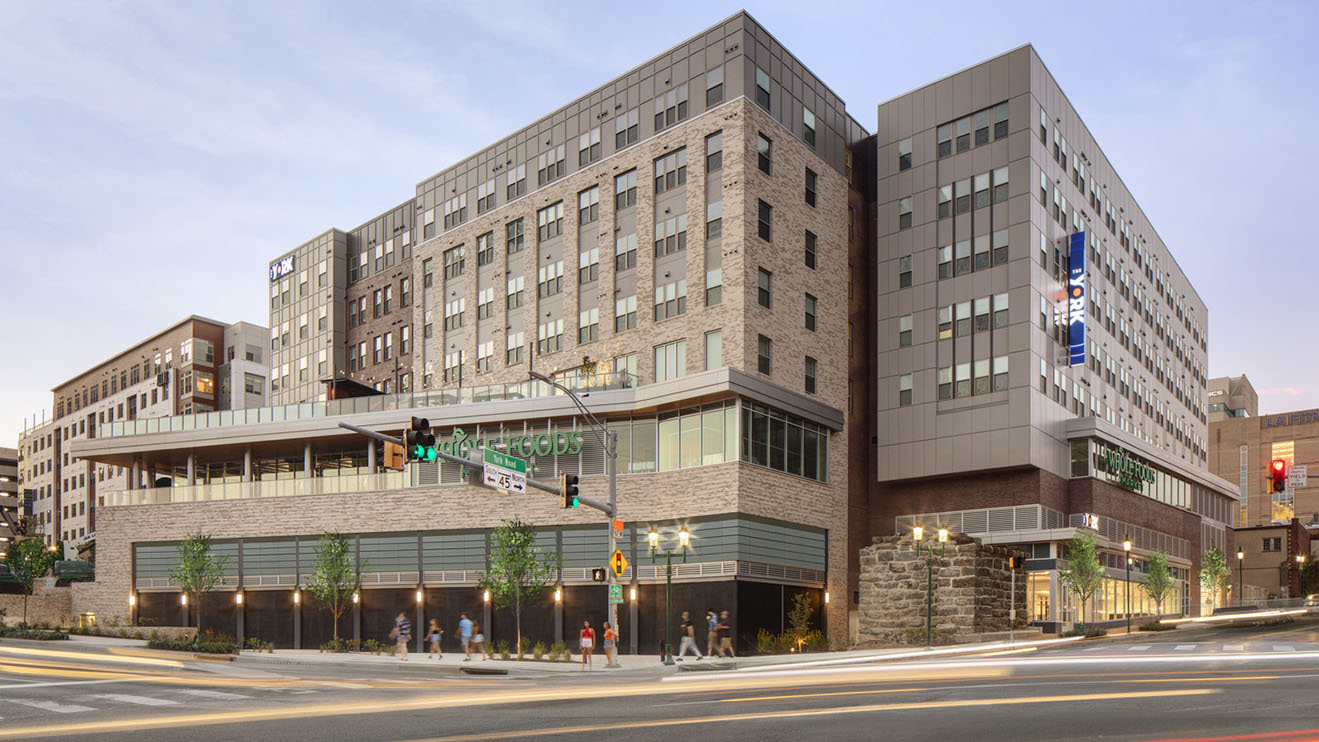Setting New Stormwater Standards for Market Terminal
As part of the revitalization of the Union Market District in Washington, D.C., Bohler designed one of the city’s first overall stormwater management master plans. The approach gave the developer maximum flexibility to transform a site within the storied industrial neighborhood into a mixed-use residential, office, and retail community called Market Terminal.
Bohler chose the overall stormwater management master plan solution because maximizing density on an urban site leaves little room for utilities and stormwater management facilities, especially when a site is subdivided. The approach allowed the developer, to divide the site into separate parcels to sell or lease to other developers, while maintaining flexibility for site planning and individual building layout. An overall stormwater management master plan made this easier because it maintains the parcels as one site, allowing them to meet the city’s environmental regulations together rather than individually.
As a result, the design team was able to maximize density for each parcel, and strategically locate amenities and stormwater management facilities in places where they could best serve the end users.
Envisioning a Vibrant Community
Market Terminal is part of the renewal of Union Market District. At the heart of the district is an indoor food and shopping market once known as Union Terminal Market. Built in 1931 near the Baltimore and Ohio Railroad Freight Terminal, Union Terminal Market was D.C.’s largest market for vendors selling fresh meats, fish, dairy, and produce to feed the city’s growing population.
In the 1960s, as the city tightened regulations around the outdoor sale of meat and eggs, the market moved into a newly constructed building on the site. By the 1980s, that building fell into disrepair and many of the vendors vanished. In the ensuing decades, the once-bustling market served as an industrial warehouse, car repair shop, and long-term parking area. But in 2012, developer EDENS transformed it into a modern food and shopping destination known simply as Union Market.
Recognizing the potential of the up-and-coming neighborhood around the market, the original developer, Kettler, a Virginia-based multifamily development company, purchased a five-acre Union Market District site with plans to create a vibrant mixed-use, transit-oriented community. Today, the six-building Market Terminal development includes award-winning office space at Signal House, as well as multifamily residential and ground floor retail.
Expediting Permitting and Entitlements
When Kettler initially purchased the property, it was zoned industrial. To bring the mixed-use community to life, the project team needed to change the zoning to a Production, Distribution, and Repair Zone (PDR-1). In D.C., this typically involves a time-intensive comprehensive plan revision process. However, Bohler recommended a more efficient alternative – the Planned Unit Development (PUD) process.
Bohler managed the PUD process, engaging multiple departments simultaneously to cohesively review project plans on an expedited timeline. Together, the reviewing departments determined the public proffers that Kettler needed to provide. They included new roadways, curbs, and utility connections for every building.
In the PUD process, public agencies maintain the utilities, but a private development association, which typically comprises the developers involved in establishing a community, is formed to maintain the new streets and other aspects of the community. In this case, the development association includes Kettler, Carmel Partners, Carr Properties, and Grosvenor.
Establishing an Overall Stormwater Master Plan
To allow Kettler to calculate the site’s stormwater management and green area ratio as an overall master plan (as opposed to being calculated for each individual lot), Bohler first helped to create area and taxation (A&T) lots, which are like condominium lots. With this approach, Kettler could now sell or lease the separate parcels, but the overall site is still considered a single record lot for stormwater management calculation purposes.
When the site is fully built out, stormwater management for the entire site must meet the D.C. Department of Energy and Environment (DOEE) requirements, but it doesn’t matter how. For example, each parcel plays a part in the overall stormwater management plan, but some will exceed the parcel requirements while others will fall short based on the amenity packages, aesthetics, and available space.
Guiding one of the first and most complex overall stormwater management master plans approved by DOEE, Bohler helped the agency develop the rules and standards for this approach. To meet stormwater management requirements for the overall site, Bohler’s designs include:
- Permeable pavement, rain gardens, and bioretention tree pits within the streetscape;
- On-site water recycling through a basement cistern in one building; and
- Green roof components on all building roofs.
Together, these methods for handling the site’s stormwater helped reduce the number of stormwater retention credits (SRC) the development association needed to purchase from elsewhere in the city to fully adhere to all DOEE requirements.
Streamlining Survey
Bohler’s in-house survey team helped to streamline the project at each critical phase. The team performed the initial ALTA/NSPS land title survey to support due diligence, assisting with the purchase of the property and providing topography to inform site civil design. Bohler also performed utility surveys that provided critical data for the storm sewer, sanitary sewer and waterline system layout and design.
Further supporting design and approvals, Bohler surveyors provided subdivision, tax lot division, condominium and easement platting services. To streamline construction, they performed construction stakeout services for all infrastructure, hardscape features, buildings, parks and roadways.
To assist in closing the construction loan, Bohler will provide DC wall checks, DC Water as-builts, DOEE stormwater management as-builts and ALTA/NSPS land title survey.
Collaborating to Maintain Forward Momentum
Developer EDENS owns a portion of nearly all ground-floor retail space throughout the Union Market District, and strives to create a unique, but cohesive feel throughout the community. As the master developer, Kettler coordinated closely with EDENS to ensure the master plan aligned with their vision.
In 2018, Carmel Partners became the majority owner of Market Terminal. Carmel Partners developed three of the residential parcels while selling one parcel to Carr Properties for an office building, and Grosvenor for another residential tower. Each of these development partners had its own design team of architects, structural engineers, and other consultants.
Though the same general contractor was used for most of the parcels, Bohler’s coordination efforts helped to streamline construction and avoid potential conflicts between buildings.
During the site planning and design phase, Bohler’s team coordinated all drawings for each of the different development teams to ensure that all stakeholders were working with the latest set of design documents. As the common link between all the external teams, Bohler also ensured that all utility and stormwater management designs worked for both individual parcels as well as cohesively with the overall site design.
Create Project Momentum
Our approach makes a meaningful difference for our most ambitious clients. Contact us to learn more.
Let's Get Started
